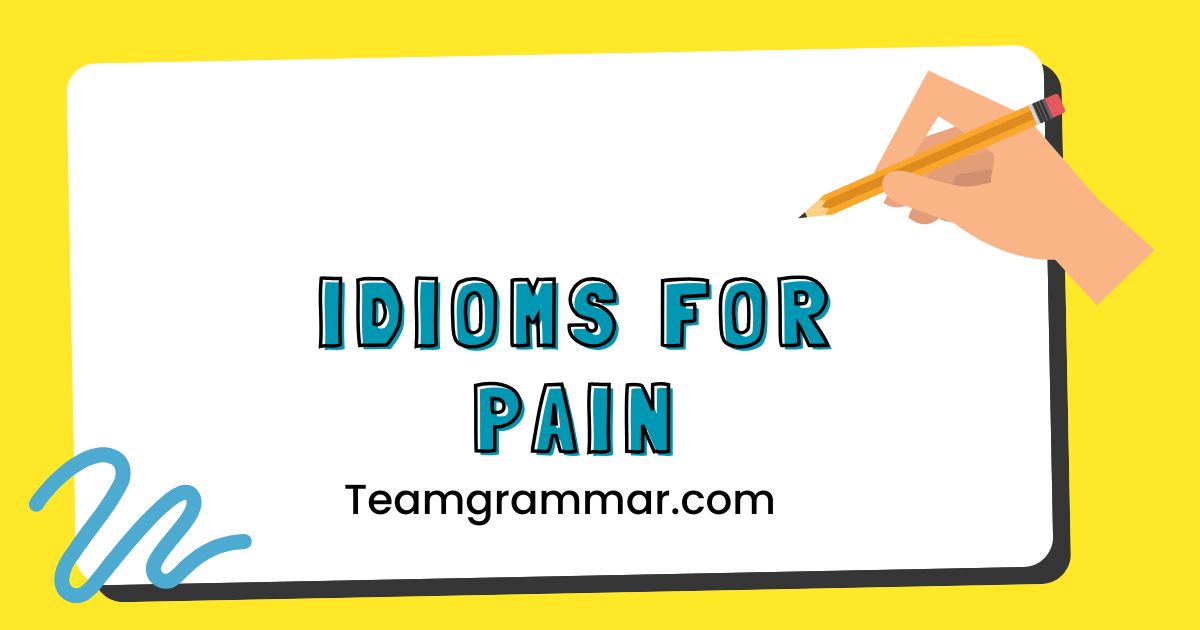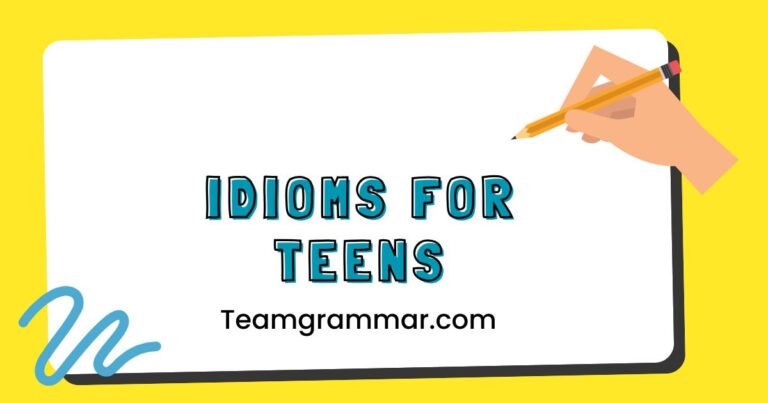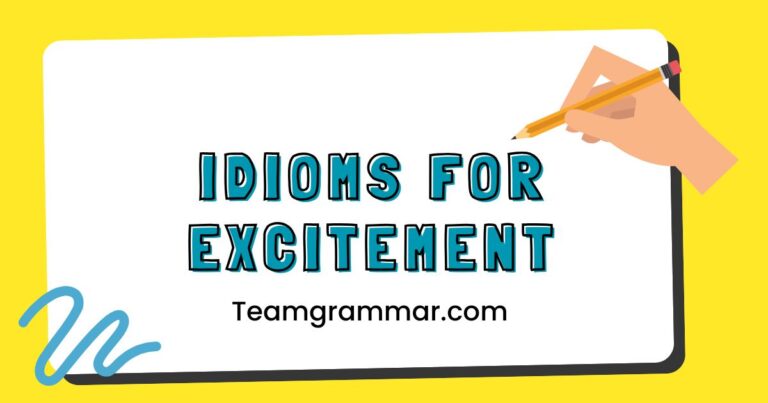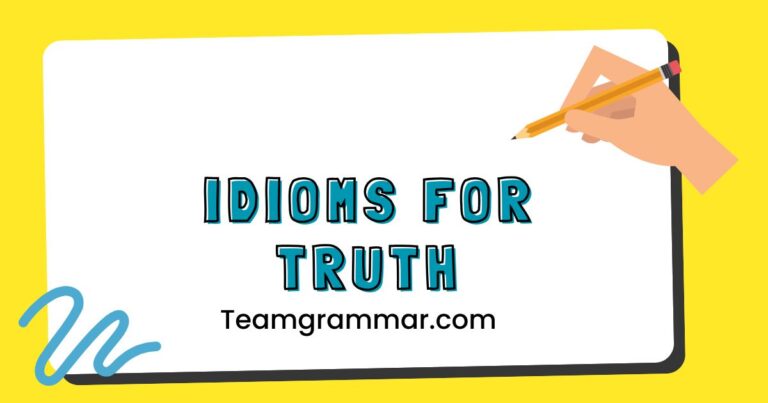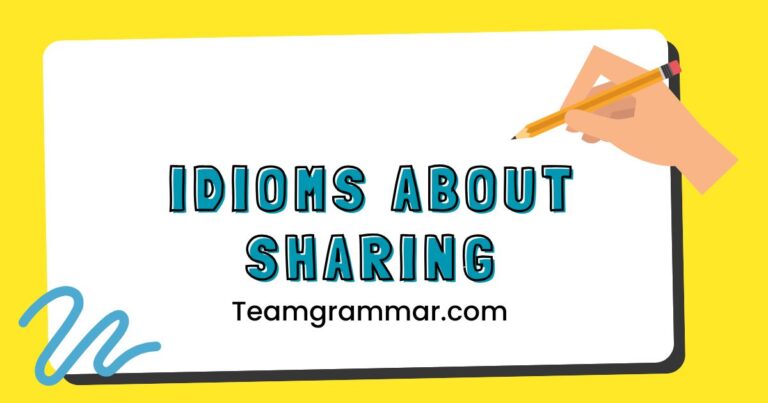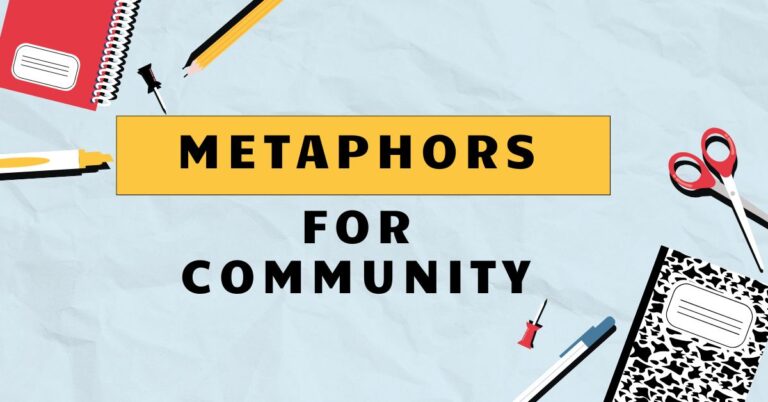43 Idioms for Pain: Expressing Suffering in English
Understanding idioms is crucial for mastering English, as they add color and depth to communication. Idioms related to pain are particularly useful for expressing a wide range of experiences, from physical discomfort to emotional distress.
This article explores common idioms used to describe pain, providing clear definitions, examples, and practice exercises. Whether you’re an English language learner or a native speaker looking to expand your vocabulary, this guide will help you articulate your feelings more effectively and understand others with greater nuance.
Table of Contents
- Introduction
- Definition of Idioms for Pain
- Structural Breakdown
- Types and Categories of Pain Idioms
- Examples of Pain Idioms
- Usage Rules for Pain Idioms
- Common Mistakes with Pain Idioms
- Practice Exercises
- Advanced Topics
- FAQ
- Conclusion
Definition of Idioms for Pain
An idiom is a phrase or expression whose meaning cannot be understood from the literal meanings of the individual words. Instead, the phrase has a figurative meaning that is known through common usage.
Idioms for pain are expressions that describe physical, emotional, or mental suffering in a non-literal way. These idioms often use vivid imagery and metaphors to convey the intensity and nature of the pain being experienced.
Understanding these idioms is essential for comprehending spoken and written English, as they are frequently used in everyday conversation and literature.
Idioms related to pain can be classified based on the type of pain they describe: physical, emotional, or mental. Physical pain idioms refer to bodily discomfort or injury.
Emotional pain idioms describe feelings of sadness, grief, or heartbreak. Mental pain idioms relate to stress, anxiety, or cognitive difficulties.
The function of these idioms is to provide a more expressive and nuanced way to communicate about pain, allowing speakers and writers to convey the severity and impact of their experiences. The contexts in which pain idioms are used vary widely, ranging from casual conversations to formal writing.
Structural Breakdown
The structure of idioms for pain varies widely depending on the specific idiom. Some idioms are simple phrases consisting of a few words, while others are more complex sentences.
Many pain idioms involve metaphors, similes, or other figures of speech. For example, the idiom “a pain in the neck” uses a metaphor to compare someone or something annoying to a physical pain.
The idiom “to be stabbed in the back” uses imagery to describe betrayal and emotional pain. Another common structure involves using verbs related to physical pain to describe emotional or mental suffering, such as “to ache for someone” or “to be torn apart.”
Understanding the structural elements of idioms involves recognizing the figurative language being used and interpreting the intended meaning. It is also important to be aware of the grammatical context in which the idiom is used.
For example, some idioms can be used as nouns, verbs, or adjectives, depending on the sentence structure. The patterns and rules governing the use of idioms are often idiomatic themselves, meaning that they do not follow standard grammatical rules.
As such, learning idioms requires memorization and exposure to a wide range of examples.
Types and Categories of Pain Idioms
Physical Pain Idioms
Physical pain idioms describe bodily discomfort, injury, or illness. These idioms often use vivid imagery to convey the intensity and nature of the pain.
Examples include “a splitting headache,” “a stabbing pain,” and “to be black and blue.” These idioms help to communicate the specific type and severity of physical pain being experienced.
Emotional Pain Idioms
Emotional pain idioms describe feelings of sadness, grief, heartbreak, or betrayal. These idioms often use metaphors to compare emotional suffering to physical pain.
Examples include “a broken heart,” “to be heartbroken,” and “to be torn apart.” These idioms provide a way to express the deep and often overwhelming nature of emotional pain.
Mental Pain Idioms
Mental pain idioms describe stress, anxiety, cognitive difficulties, or other forms of mental suffering. These idioms often use imagery to convey the feeling of being overwhelmed or burdened.
Examples include “to be at wit’s end,” “to be stressed out,” and “to have a lot on one’s plate.” These idioms help to communicate the challenges and difficulties associated with mental pain.
Examples of Pain Idioms
Physical Pain Examples
Below is a table providing a variety of physical pain idioms along with example sentences illustrating their usage. These idioms help to paint a more vivid picture of the physical discomfort being described.
| Idiom | Meaning | Example Sentence |
|---|---|---|
| A splitting headache | A severe headache | I have a splitting headache after staring at the computer all day. |
| A stabbing pain | A sharp, sudden pain | She felt a stabbing pain in her chest and immediately called for help. |
| Black and blue | Bruised | After the accident, his arm was black and blue. |
| To be under the weather | To feel unwell | I’m feeling a bit under the weather today, so I’m staying home from work. |
| To feel like death warmed over | To feel extremely ill | After the flu, I felt like death warmed over for days. |
| To be on one’s last legs | To be near collapse or failure (can refer to health) | The old car is on its last legs, and I’m surprised it still runs. |
| To have a frog in one’s throat | To have difficulty speaking due to a throat irritation | I had a frog in my throat during the presentation, so I kept clearing my throat. |
| To be as fit as a fiddle | To be in excellent health | Despite his age, he’s as fit as a fiddle. |
| To kick the bucket | To die | He was afraid he would kick the bucket before seeing his grandchildren grow up. |
| To be at death’s door | To be very close to dying | After the surgery, he was at death’s door, but he eventually recovered. |
| To be pushing up daisies | To be dead and buried | If I fail this exam, I might as well be pushing up daisies. |
| To bite the dust | To die or fail | The company finally bit the dust after years of financial struggles. |
| To feel a twinge | To experience a sudden, slight pain | I felt a twinge in my back when I lifted the heavy box. |
| A throbbing pain | A pain that pulsates | She had a throbbing pain in her temples from the stress. |
| To be laid up | To be confined to bed due to illness or injury | He was laid up with the flu for a week. |
| To be out of sorts | To feel slightly unwell or unhappy | I’ve been feeling out of sorts all day; I think I’m getting a cold. |
| To have a pain in the neck | To be annoying or troublesome | Dealing with these constant complaints is a real pain in the neck. |
| To be on the mend | To be recovering from illness or injury | After the surgery, she was slowly on the mend. |
| To be as right as rain | To be perfectly healthy | After a good night’s sleep, I felt as right as rain. |
| To be in tip-top shape | To be in excellent physical condition | He trains every day to stay in tip-top shape. |
| To be hale and hearty | To be healthy and vigorous, especially in old age | My grandfather is still hale and hearty at 85 years old. |
| To be full of beans | To be energetic and lively | The kids were full of beans after their nap. |
| To be given a clean bill of health | To be declared healthy by a doctor | After the check-up, the doctor gave me a clean bill of health. |
Emotional Pain Examples
The following table provides a variety of emotional pain idioms, along with example sentences to show their usage. These idioms are crucial for expressing the nuanced and often complex feelings of emotional distress.
| Idiom | Meaning | Example Sentence |
|---|---|---|
| A broken heart | Emotional distress caused by the end of a relationship | She had a broken heart after her boyfriend left her. |
| Heartbroken | Extremely sad or disappointed | He was heartbroken when he didn’t get the job. |
| Torn apart | Extremely distressed or upset | She was torn apart by the news of her friend’s accident. |
| To be down in the dumps | To feel sad or depressed | He’s been down in the dumps ever since he lost his job. |
| To have a heavy heart | To feel sad or burdened | She had a heavy heart as she said goodbye to her family. |
| To be in the doldrums | To be in a state of inactivity or depression | The team has been in the doldrums since their star player was injured. |
| To feel blue | To feel sad or depressed | I’m feeling a little blue today because it’s raining. |
| To cry one’s heart out | To cry intensely | She cried her heart out when she heard the news. |
| To wear one’s heart on one’s sleeve | To openly show one’s emotions | He wears his heart on his sleeve, so everyone knows how he’s feeling. |
| To stab someone in the back | To betray someone | He stabbed me in the back by telling my boss about my mistake. |
| To feel like a fish out of water | To feel uncomfortable or out of place | I felt like a fish out of water at the fancy party. |
| To be at the end of one’s rope | To be at the limit of one’s endurance | She was at the end of her rope after dealing with the difficult client all day. |
| To hit rock bottom | To reach the lowest point in one’s life | He hit rock bottom when he lost his home and his job. |
| To be a glutton for punishment | To willingly endure hardship | He must be a glutton for punishment to keep working in that stressful job. |
| To feel like one’s world is falling apart | To feel that one’s life is collapsing | She felt like her world was falling apart when her husband left her. |
| To have a lump in one’s throat | To feel emotional and choked up | I had a lump in my throat during the farewell speech. |
| To feel like a weight has been lifted | To feel relieved | I felt like a weight had been lifted after I finished the project. |
| To be sick at heart | To be deeply saddened or disgusted | I was sick at heart when I saw the condition of the animals. |
| To be crestfallen | To be disappointed and dejected | He was crestfallen when he didn’t make the team. |
| To be gutted | To be extremely disappointed | She was gutted when she missed the deadline. |
| To feel deflated | To feel less confident or enthusiastic | He felt deflated after his presentation was poorly received. |
| To be in despair | To be in a state of hopelessness | They were in despair after losing everything in the fire. |
| To be grief-stricken | To be overwhelmed by grief | She was grief-stricken after the death of her mother. |
| To be inconsolable | To be unable to be comforted | He was inconsolable after the loss of his pet. |
Mental Pain Examples
The table below demonstrates idioms related to mental pain, providing example sentences for each. These idioms are helpful in articulating the often invisible struggles of mental and emotional burden.
| Idiom | Meaning | Example Sentence |
|---|---|---|
| To be at wit’s end | To be unable to think of a solution | I’m at wit’s end trying to fix this computer problem. |
| To be stressed out | To be feeling overwhelmed by stress | She’s been stressed out about the upcoming exam. |
| To have a lot on one’s plate | To have many responsibilities or tasks | I have a lot on my plate right now, so I can’t take on any more projects. |
| To be pulling one’s hair out | To be extremely frustrated | I’m pulling my hair out trying to understand this math problem. |
| To be tearing one’s hair out | To be extremely frustrated or worried | The manager was tearing his hair out trying to meet the impossible deadline. |
| To be driven up the wall | To be annoyed or frustrated | The constant noise from the construction is driving me up the wall. |
| To be climbing the walls | To be restless or anxious | The kids were climbing the walls on the rainy day. |
| To be frazzled | To be exhausted and stressed | She felt frazzled after a long day of meetings. |
| To be on edge | To be nervous or anxious | I’ve been on edge all day waiting for the phone call. |
| To be at the breaking point | To be at the limit of one’s ability to cope | She was at the breaking point after weeks of sleepless nights. |
| To be burned out | To be exhausted from overwork | He was burned out after working long hours for months. |
| To be losing one’s mind | To be going crazy or becoming irrational | I’m losing my mind trying to find my keys. |
| To be going bananas | To be acting crazy or excited | The crowd went bananas when the band came on stage. |
| To be out of one’s mind | To be crazy or irrational | You must be out of your mind to think that’s a good idea. |
| To be driven to distraction | To be extremely annoyed | The loud music was driving me to distraction. |
| To be banging one’s head against a brick wall | To be trying to do something impossible | I feel like I’m banging my head against a brick wall trying to get him to understand. |
| To be tearing one’s hair out | To be extremely frustrated | She was tearing her hair out trying to meet the deadline. |
| To be racking one’s brains | To be trying hard to remember something | I’ve been racking my brains trying to remember his name. |
| To be in a fog | To be confused or disoriented | I was in a fog after waking up from the surgery. |
| To be up against it | To be facing difficulties | He’s really up against it trying to get the project finished on time. |
| To be snowed under | To be overwhelmed with work | I’m completely snowed under with paperwork at the moment. |
| To have one’s hands full | To be very busy | She has her hands full with three young children. |
| To be swamped | To be overwhelmed with too much to do | I’m swamped with emails and phone calls today. |
| To be stretched thin | To be trying to do too many things at once | The staff is stretched thin since the budget cuts. |
Usage Rules for Pain Idioms
Using idioms correctly involves understanding their specific meanings and contexts. It is important to use idioms in situations where they are appropriate and will be understood by the audience.
Overusing idioms can make your language sound unnatural or forced. In formal writing, it is generally best to use idioms sparingly, as they can be seen as informal or colloquial.
However, in informal conversations, idioms can add color and expressiveness to your language.
One key rule is to ensure the idiom fits grammatically into the sentence. Idioms can function as nouns, verbs, adjectives, or adverbs, so make sure the idiom’s grammatical role aligns with the sentence’s structure.
Also, be mindful of the audience. Some idioms are more common in certain regions or age groups, so choose idioms that your audience will understand.
Finally, practice using idioms in context to become more comfortable and confident in their usage. Pay attention to how native speakers use idioms in conversations and writing, and try to incorporate them into your own language.
Common Mistakes with Pain Idioms
One common mistake is misunderstanding the meaning of an idiom and using it incorrectly. For example, someone might mistakenly use “a pain in the neck” to describe a physical injury instead of an annoying person or situation.
Another common mistake is using an idiom out of context, such as using a very informal idiom in a formal setting. Additionally, some learners try to create their own variations of idioms, which can sound unnatural or confusing.
It’s best to use idioms as they are traditionally used.
Here are some examples of common mistakes and their corrections:
| Incorrect | Correct | Explanation |
|---|---|---|
| “I have a splitting leg.” | “I have a splitting headache.” | “Splitting” is typically used with “headache,” not other body parts. |
| “He is blue because of the weather, literally.” | “He is feeling blue because of the weather.” | “Feeling blue” is the idiom for sadness, not literal blueness. |
| “She was broken arm after the breakup.” | “She had a broken heart after the breakup.” | “Broken heart” is the idiom for emotional distress. |
| “He hit bottom rock.” | “He hit rock bottom.” | The correct order is “rock bottom.” |
| “I’m pulling my hair out of frustration.” | “I’m pulling my hair out” | The “of frustration” is redundant, as the idiom already implies frustration. |
Practice Exercises
Test your understanding of pain idioms with the following exercises. Fill in the blanks with the appropriate idiom from the list provided.
Idiom List: splitting headache, broken heart, under the weather, at wit’s end, stabbing pain, down in the dumps, pain in the neck, on edge, tearing one’s hair out, heavy heart
| Question | Answer |
|---|---|
| 1. I have a terrible _______ after working on the computer all day. | splitting headache |
| 2. She’s been _______ ever since she lost her job. | down in the dumps |
| 3. Dealing with these constant complaints is a real _______. | pain in the neck |
| 4. He’s been _______ waiting for the results of his medical tests. | on edge |
| 5. She had a _______ after her boyfriend broke up with her. | broken heart |
| 6. I’m feeling a bit _______ today, so I’m staying home from work. | under the weather |
| 7. I’m _______ trying to fix this computer problem. | at wit’s end |
| 8. She felt a _______ in her chest and immediately called for help. | stabbing pain |
| 9. She was _______ trying to meet the deadline. | tearing one’s hair out |
| 10. He said goodbye to his family with a _______. | heavy heart |
Exercise 2: Choose the correct idiom to complete each sentence.
| Question | Options | Answer |
|---|---|---|
| 1. After the long day, she felt completely _______. | (a) snowed under (b) burned out (c) full of beans | (b) burned out |
| 2. He _______ when he realized he had lost his wallet. | (a) hit rock bottom (b) went bananas (c) felt blue | (b) went bananas |
| 3. I’m _______ with work right now, so I can’t take on any more projects. | (a) pushing up daisies (b) snowed under (c) on the mend | (b) snowed under |
| 4. She _______ after the death of her beloved pet. | (a) cried her heart out (b) was at wit’s end (c) felt like a fish out of water | (a) cried her heart out |
| 5. He’s been _______ since his business failed. | (a) in tip-top shape (b) down in the dumps (c) as right as rain | (b) down in the dumps |
| 6. The constant interruptions were _______ . | (a) driving me up the wall (b) giving me a clean bill of health (c) making me feel blue | (a) driving me up the wall |
| 7. After a good night’s sleep, I felt _______. | (a) as right as rain (b) at death’s door (c) under the weather | (a) as right as rain |
| 8. She _______ trying to remember where she parked her car. | (a) was pushing up daisies (b) was racking her brains (c) was biting the dust | (b) was racking her brains |
| 9. He felt like _______ at the exclusive party. | (a) a glutton for punishment (b) a fish out of water (c) a pain in the neck | (b) a fish out of water |
| 10. After weeks of illness, he was finally _______. | (a) on the mend (b) at the end of his rope (c) at death’s door | (a) on the mend |
Advanced Topics
For advanced learners, exploring the origins and etymology of pain idioms can provide a deeper understanding of their meanings and cultural significance. Many idioms have historical roots that shed light on their figurative usage.
For example, the idiom “kick the bucket” is believed to have originated from the practice of hanging animals by their feet from a bucket while slaughtering them. Understanding the historical context can help learners appreciate the richness and complexity of idioms.
Another advanced topic is the use of idioms in literature and rhetoric. Authors and speakers often use idioms to create vivid imagery, convey emotions, and engage their audience.
Analyzing how idioms are used in different literary genres and rhetorical contexts can enhance learners’ comprehension and analytical skills. Additionally, exploring cross-cultural differences in pain idioms can broaden learners’ perspectives and improve their intercultural communication skills.
Different cultures may have different ways of expressing pain, and understanding these differences can help avoid misunderstandings and promote empathy.
FAQ
- What is the difference between an idiom and a metaphor?
An idiom is a phrase whose meaning is not deducible from the literal meanings of the words. A metaphor is a figure of speech that directly compares two unrelated things. While many idioms use metaphors, not all metaphors are idioms. For example, “a broken heart” is an idiom that uses a metaphor, but “the world is a stage” is a metaphor that is not an idiom.
- How can I learn idioms more effectively?
The best way to learn idioms is through exposure and practice. Read widely, listen to native speakers, and pay attention to how idioms are used in context. Keep a notebook of new idioms and review them regularly. Practice using idioms in your own speaking and writing to become more comfortable with them. Flashcards and online resources can also be helpful for memorizing idioms.
- Are idioms used in formal writing?
Idioms are generally used more often in informal speech and writing. In formal writing, it is best to use idioms sparingly, as they can be seen as colloquial or informal. However, some idioms are more widely accepted and can be used in formal writing if they are appropriate for the context and audience.
- Can I create my own idioms?
While it is possible to create new phrases, they will not be considered idioms unless they are widely adopted and used by native speakers. Idioms are established expressions with a specific meaning that is understood by the community of speakers. Creating your own variations of idioms can sound unnatural or confusing.
- How do I know when to use an idiom?
Use idioms when they are appropriate for the context, audience, and purpose of your communication. Consider whether the idiom will be understood by your audience and whether it adds value to your message. Avoid overusing idioms, as this can make your language sound unnatural or forced.
- What should I do if I don’t understand an idiom?
If you encounter an idiom that you don’t understand, ask for clarification. You can ask the speaker or writer to explain the meaning of the idiom or you can look it up in a dictionary or online resource. Pay attention to the context in which the idiom is used, as this can often provide clues about its meaning.
- Are idioms universal across languages?
No, idioms are not universal across languages. Each language has its own unique set of idioms that reflect its culture and history. While some idioms may have similar meanings in different languages, they are often expressed differently. Learning idioms in a new language requires studying the specific expressions used in that language.
- How do I avoid misusing idioms?
To avoid misusing idioms, ensure you fully understand their meaning and context. Pay attention to how native speakers use them and practice using them yourself. If you’re unsure, it’s better to use a more literal expression to ensure clarity. Also, be aware that some idioms are more appropriate for certain regions or age groups.
- Why are idioms important in learning English?
Idioms are essential for understanding native English speakers and for expressing yourself more naturally. They add color and depth to communication and help you convey nuanced meanings that literal language cannot capture. Mastering idioms can significantly improve your fluency and comprehension.
- Are there any resources that can help me learn idioms?
Yes, there are many resources available to help you learn idioms. Dictionaries, online resources, textbooks, and language learning apps often include sections on idioms. Additionally, watching English-language movies and TV shows, reading books, and listening to podcasts can expose you to idioms in context.
Conclusion
Understanding and using idioms for pain is an essential aspect of mastering the English language. These expressions provide a nuanced and expressive way to communicate about physical, emotional, and mental suffering.
By learning the definitions, structures, and usage rules of pain idioms, you can enhance your comprehension of spoken and written English and articulate your feelings more effectively. Remember to practice using idioms in context and be mindful of your audience and the formality of the situation.
Continue to expand your knowledge of idioms by reading widely, listening to native speakers, and using online resources. Pay attention to how idioms are used in different contexts and practice incorporating them into your own language.
With consistent effort, you will become more confident and proficient in using idioms for pain and other expressions, enriching your overall communication skills in English. Embrace the challenge and enjoy the process of discovering the colorful and expressive world of English idioms.

